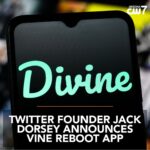The Return of Vine? How diVine Is Rebuilding Without AI”

DiVine (sometimes stylized “Divine”) is a fresh attempt to resurrect Vine, the beloved six-second, looping video app that was shut down by Twitter back in 2016/201. It’s backed by former Twitter CEO, Jack Dorsey, via his nonprofit called “and Other Stuff.”
Jack Dorsey Divine App
On launch, diVine is bringing in over 100,000 archived Vine videos, reconstructed from huge binary backup files preserved before Vine shut down. The effort to restore all this was led by Evan Henshaw-Plath, better known in the tech world as “Rabble.” He’s an early Twitter employee, so there’s real legacy DNA in this project
How It Works
Unlike the original Vine, diVine isn’t just for nostalgia. You can make new six-second looping videos, upload them, and build a profile. The team is also embracing decentralization — it’s built on Nostr, an open-source protocol Dorsey supports. That means developers could set up their own relays, servers; in theory, you don’t have to rely on a centralized corporate owner.
One of the boldest parts? AI-generated content is blocked. Yes, if a video is flagged as being made (or heavily edited) by generative AI, it’s not allowed to post. To enforce this, diVine is using technology from the Guardian Project (a human rights org) to verify that new uploads were actually captured on a real smartphone, among other checks.
They even plan to badge content that’s verified “real human, no AI.”
Why Dorsey Is Involved
Dorsey’s role is through his nonprofit “and Other Stuff”, which was created earlier in 2025. The nonprofit isn’t about chasing massive profits; it more supports “experimental open-source projects and tools capable of transforming the social media landscape.”
Dorsey has made a pointed statement on why diVine is on Nostr:
“Nostr … is empowering developers to create a new generation of apps without the need for VC-backing, toxic business models or huge teams of engineers.”
He sees diVine as more than revival, it’s a demonstration of what social media could be like if it weren’t controlled by centralized power or chasing the next billion-dollar exit.
What’s In the Archive And Who Owns It
Rabble (the founder) says they’ve recovered about 150,000–200,000 videos, spanning roughly 60,000 creators. That’s a “good percentage” of what was popular, though not everything made it. Some corners of Vine, like millions of K-pop videos, apparently weren’t archived.
Importantly, creators still own the copyright to their original Vines. If someone wants their old videos removed, they can file a DMCA takedown, or verify they’re the original creator by proving control of their old social accounts linked in their Vine bio. Once verified, they can even reclaim their old Vine profile on diVine or upload old content that might have been missed in the initial archive.
Why the Anti-AI Stance?
This is where things get interesting. The diVine team is very clear: they’re building this in direct opposition to what they call an “AI takeover” of social media. On their website, they explain that platforms are being flooded with “AI slop”, videos that “look real but were never captured by a camera … made by an algorithm.”
Rabble has described diVine as a reaction to that:
“There’s this bullshit that we’re seeing from Meta and OpenAI and others where they decided that somehow we’re better off with all AI-created social media content,” he told Business Insider. He argues that “social media was social first. It’s about humans and our connection … not just pretty videos.”
He also talked about something called “enshittification”, a term coined by author Cory Doctorow. It refers to how big platforms degrade over time, prioritizing shareholders over users. Rabble said:
“DiVine … is my attempt to fight back … in code.”
What’s the Current Status
As of mid-November 2025, diVine is in beta and not fully in the app stores yet. The web version is live for now, and they’ve already onboarded 10,000 users for the iOS beta. There are still bugs, though not all the archived Vines will play properly.
Because diVine is built on Nostr, it’s very different from traditional social apps. If this works, developers could spin up their own versions, host their own relays, and really control how content flows.
Monetization? Rabble has floated a Twitch-like model: micropayments, small transactions, maybe some in-app donations. He’s clear he’s not building a TikTok clone that chases scale at all costs.
Reactions & Criticism
There’s been a wave of nostalgia; people are genuinely excited. diVine feels like a return to simpler, more human internet days. Some early reactions are positive, especially among folks who miss the original Vine humor, the quick loops, the creative freedom.
But not everyone is just “aww, Vine’s back.” On Reddit, a few users are skeptical. Some argue that banning AI content is more complicated than it sounds. How do you reliably detect what is or isn’t AI-generated? Others question motives: is this really about purity, or is it still a business in disguise? One comment said:
“The renewed Vine app … doesn’t allow AI … because they’re going to use it to train AI models … don’t go downloading thinking it’s a ‘safe haven.’”
There’s also chatter about decentralized protocols. Some point out that Nostr isn’t exactly the Fediverse (the network of Mastodon, Pleroma, etc.), though it’s open and allows for independent hosting.
Why DiVine Actually Matters
At a time when so much of social media is dominated by algorithmic feeds and AI-generated content, diVine feels like the change we need. Jack Dorsey’s involvement gives it weight. He’s not building this for a billion-user exit; he’s backing it through a nonprofit. And Rabble? He’s not just chasing nostalgia, he’s building something open, decentralized, and human. That, in today’s social media climate, is a pretty radical act.




